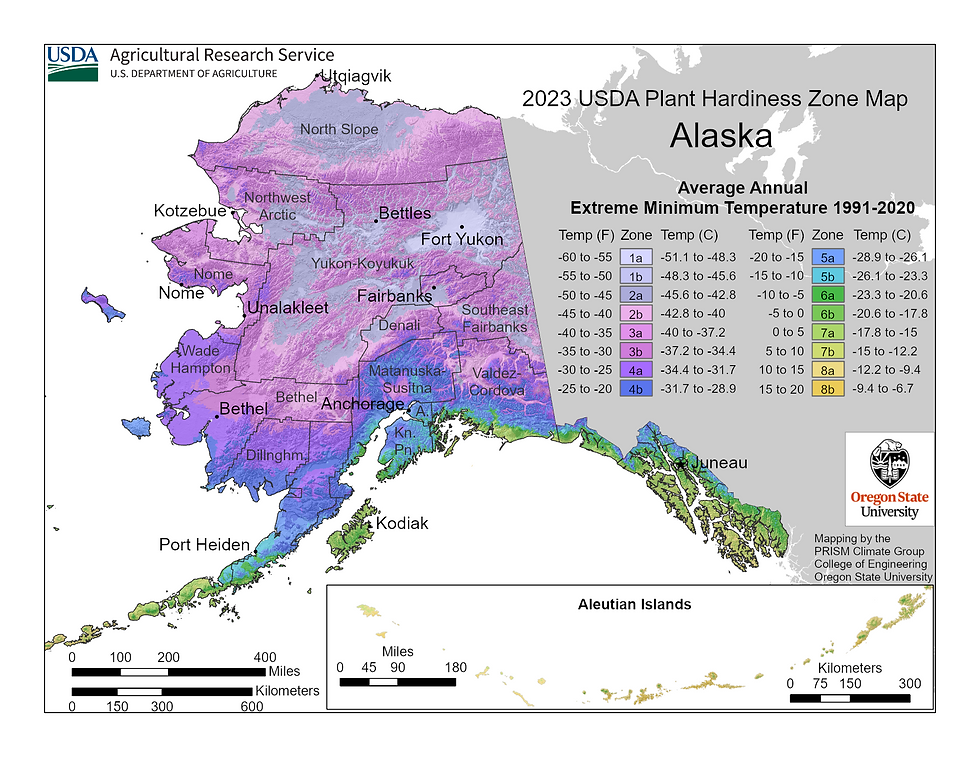USDA Hardiness Zones Across the U.S. - Spotlight on Alaska!
- Marcus Bergin

- Aug 14, 2024
- 2 min read
Discover Your USDA Hardiness Zone!
Gardening in Alaska presents unique challenges and opportunities due to its diverse climate zones, from the frigid northern regions to the milder southern coasts. Understanding your USDA Hardiness Zone is key to selecting plants that will thrive in Alaska’s extreme conditions. Let’s explore the zones across Alaska and discover the best shade-tolerant plants for your garden!

Alaska: Zones 1-7
Alaska’s climate ranges from the cold Arctic regions in the north to the more temperate areas in the south. Here’s a closer look at the zones in Alaska and some shade-tolerant plants that will thrive in each:
Zone 1-2:
Found in the northernmost parts of Alaska, including areas like Barrow and parts of the Arctic region, where winter temperatures can drop below -50°F. These hardy, shade-tolerant plants are suited for the harshest conditions:
Alpine Aster (Aster alpinus): Adapted to extreme cold, this plant provides vibrant color even in the harshest conditions.
Snowberry (Symphoricarpos albus): A resilient shrub that can handle extreme cold and adds visual interest to shaded areas.
Siberian Iris (Iris sibirica): Thrives in cooler climates and provides beautiful blooms in shaded garden areas.
Zone 3-4:
Covers much of central Alaska, including regions like Fairbanks and Anchorage, where winter temperatures range from -40 to -30°F. This zone supports a variety of shade-tolerant plants:
Hellebores (Helleborus spp.): Known for their ability to bloom early in spring, Hellebores are well-suited for colder, shaded areas.
Hostas (Hosta spp.): Ideal for adding lush foliage to shaded spots in cooler climates.
Astilbe (Astilbe spp.): With its feathery plumes of flowers, Astilbe brightens up shaded gardens and thrives in cooler conditions.
Zone 5-7:
Includes the southern parts of Alaska, including cities like Juneau and the southern coastal areas, where winter temperatures range from -20 to 20°F. This warmer zone supports a range of shade-tolerant plants adapted to more temperate conditions:
Rhododendrons (Rhododendron spp.): Thrive in the shaded, acidic soils of Zone 5-7 and offer vibrant blooms in spring.
Ferns: Varieties like Lady Fern (Athyrium filix-femina) and Ostrich Fern (Matteuccia struthiopteris) are excellent for adding greenery to shaded areas.
Columbine (Aquilegia spp.): Adds delicate, colorful flowers to shaded garden beds and thrives in cooler, temperate conditions.
Why It Matters:
Optimal Plant Selection: Choosing plants suited to your specific zone ensures they will thrive despite Alaska’s challenging conditions.
Effective Garden Planning: Understanding your zone helps you plan your planting schedule to maximize the growing season in Alaska’s varied climates.
Sustainable Gardening: By selecting plants that naturally thrive in your zone’s conditions, you reduce the need for extra water, fertilizers, and pesticides, promoting a more eco-friendly garden.
Get Involved: Share Your Gardening Experience
We want to hear from you! Whether you’re gardening in the frigid northern regions of Zones 1-2 or the milder southern areas of Zones 5-7, your experiences and tips can inspire and guide others.
Join the Conversation:
Comment Below: Share your gardening successes, challenges, and questions with fellow Alaskan gardeners.
Join Our Facebook Group: Connect with a community of shade gardening enthusiasts by joining our Shade Gardening Group on Facebook. It’s a great place to exchange ideas, find inspiration, and support your gardening journey.
Let’s grow together, Alaska! 🌻




Comments